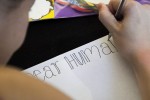In a short poem, Diamond penned that love is like a bullet wound that is barely healing.
The teenage boy did not intend to write about love in the context of violence; it was an organic thought. But Diamond felt comfortable using a violent metaphor, his mentor said. Growing up around guns made him feel like a winner until he reached a juvenile camp, Diamond wrote in his prose.
One of the inmates at Camp Fred Miller in Malibu, California, Diamond submitted his poetry and prose for display in Kerckhoff Art Gallery. Four UCLA student groups and a nonprofit called Critical Resistance Los Angeles organized “Write Back,” a gallery show that runs until Saturday. UCLA students wrote and drew responses to the work of the incarcerated youth in the form of stories and letters Thursday evening.
Social activism often takes stories out of communities without giving them anything in return, said Colleen Hamilton-Lecky, the organizer of the event from the Student Committee for the Arts. The event aims to establish a reciprocal relationship between students at UCLA and the camp by creating an artistic dialogue, said the second-year world arts and cultures student.
Sprawled across the wall of Kerckhoff Art Gallery are 13 handwritten poems, raps and proses written by 15- to 17-year-old inmates at the all-boys camp. The pieces of writing are connected to each other over the Metro map of Los Angeles.
The map alludes to the systemic and sweeping nature of mass incarceration throughout the city, Hamilton-Lecky said. It highlights the interconnectedness of the narratives of the inmates.
When she tutored at Camp Fred Miller her freshman year as part of Incarcerated Youth Tutorial Project, Hamilton-Lecky saw most boys at the camp kept journals. Apart from drawings of naked women, the journals were filled with poems and raps, which the boys were always happy to share with their tutors.
Their organic need for self-expression is fulfilled through writing, she said. Ten of the exhibited poems and proses incorporate elements of family relationships and love.
Diamond scribbled in prose in his big and bubbly penmanship, “My mom’s love is strong like Hennessy without a taste but stronger, too good to waste.”
The poems reveal the social inequities and emotional vulnerabilities of the inmates, Hamilton-Lecky said.
“Always been a young wild knucklehead roaming the streets of East LA. Never really knew what I want,” wrote one the inmates in a letter to himself. “My mom staying up every night worried, wondering if I am alright. Was searching for love and ended up with my son.”
The boys feel upset to be at the camp, and they think they have let people down, Hamilton-Lecky said.
Jyoti Gill, a fourth-year political science student and viewer at the gallery, said the kids should be punished without taking them away from their families and removing them from everything they know.
“They should not feel like they are outcast,” Gill said.
Amid several scratched-out thoughts in a poem is the couplet about family, “They are the reason of my hapiness (sic) and I cause nothing but sadness.”
Socio-economic differences like education and income levels that separate the realities of students at UCLA and at the camp are stark, Hamilton-Lecky said.
“Look at me. I’m black so arrest me. / I’m innocent I’m innocent no ‘Boy’ your (sic) guilty,” reads one of the poems with math scratch work scribbled on its back.
Jason Gosschalk, project director for IYTP at the camp and mentor to Diamond and other students, said the boys and their tutors share very few life experiences. Gosschalk, a fourth-year biochemistry student, said he never had to choose if he wanted to be in a gang, but the boys could never choose if they wanted to run for student body president.
The incarcerated are often demonized, he said. Their delinquencies are misunderstood as violent crimes. Young kids can often end up in probation camps for truancy or disruptive classroom behavior, which underlines the problem of the school-prison pipeline, Gosschalk said.
Frequently told by their teachers that they are incapable of learning, the kids think that they are not smart enough, Gosschalk said. However, their faces lit up when tutors told them they were using metaphors and similes in their work even without knowing what literary devices were.
Kasey Merten, a third-year linguistics student and visitor at “Write Back,” said the kids might think that they cannot be heard. But she wrote to them that she heard them.
“Deep inside I’m filled with rage / But never show it but I still continue to flip the page,” were the words one of the inmates concluded his poem with.
